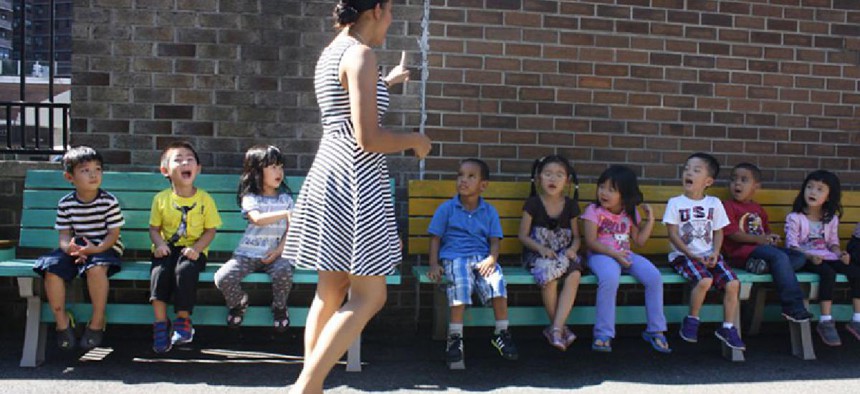When classes begin this fall, some schools will welcome their youngest students ever.
New York City is starting to make good on a pledge to provide free, full-day pre-K to children who are 3 years old, an effort announced by Mayor Bill de Blasio this spring. Dubbed 3-K for All, the initiative is an expansion of the city’s popular Pre-K for All program, which now serves 70,000 4-year-olds across the city. While the effort for younger students is starting in just two school districts, the city plans to offer it citywide by 2021.
The initial application period for 3-K wrapped up last week. There are still many questions about the city’s plan — including whether state and federal officials will help pay the more than $1 billion price tag required to make 3-K universal. But here are five things we already know about the city’s pilot program.
RELATED: Do school vouchers work? Here's what the research says
It’s starting small.
Compared with the breakneck roll-out of Pre-K for All, the education department is moving more slowly this time around. The initiative is starting with an expansion in two high-need school districts: District 7 in the South Bronx, and District 23, which covers East New York, Brownsville and Ocean Hill. There are about 650 new seats available across 28 different sites in those districts, and more could be added by the time the school year starts.
Those will build on 11,000 slots that already exist for 3-year-olds across the city. The previously existing seats are offered through the Administration for Children’s Services, which administers child care programs for low-income families.
The education department has begun offering training and services to those programs — and will take official responsibility for ACS programs starting next summer — in an attempt to streamline early education systems and ensure quality across the board.
“It really is a comprehensive effort,” said Josh Wallack, the deputy chancellor in charge of early education at the city’s education department. “They’re going to be part of the same unified system.
City officials expect to have enough room for all children in the pilot districts by fall 2018. To make the program truly universal across all school districts, New York City wants to raise funding to serve 62,000 children by 2021.
Charter schools aren’t participating — because they can’t.
Charter schools aren’t permitted by state law to provide pre-K to 3-year-olds, according to the New York City Charter School Center. For now, the city is relying on community organizations, district schools and district-run pre-K centers to serve students.
Charter schools have been slow to join the city’s pre-K program for four-year-olds, though at least 14 charter schools now participate.
When Pre-K For All launched, the city’s largest charter chain, Success Academy, refused to sign the city’s required contract, arguing the city could not legally regulate charters.
Success Academy took the issue to the state, and after earlier defeats, an appeals court in June sided with the charter operator. Now it’s up to the state education commissioner to decide how to move forward on the matter.
What about quality?
The city’s pre-K efforts are often praised for focusing on access without compromising quality. Teacher training is an integral part of the program and the city also evaluates centers based on factors such as teachers’ interactions with students and the physical classroom.
About a third of the 28 new sites participating in 3-K do not yet have ratings. Of those sites that do have ratings, about 67 percent earned a score of “good.” Only one — the city-run Learning Through Play Center on Union Avenue in the Bronx — scored “excellent.” Likewise, only one center — Sunshine Day Care in the Bronx — earned a rating of “poor.”
Those reviews are based on existing programs for 4-year-olds. Lydie Raschka, who reviews pre-K centers for the website InsideSchools, said the best way to judge a program is by seeing it for yourself.
“Most of all, trust your instincts. There is nothing better than a visit,” she wrote in a recent post.
RELATED: De Blasio strikes charter deal for New York City
Immigration status doesn’t matter.
Some child care programs run through ACS have restrictions based on a child’s immigration status because of federal funding rules. That will not be the case for the new 3-K for All seats — nor is it with Pre-K For All — and the city is providing information in more than 200 languages.
The only requirements for 3-K are that families live in New York City and children were born in 2014.
Options are limited for families looking for accessible buildings or English language support.
Most of the new sites do not appear to be accessible to students who have physical disabilities and who may, for example, require a wheelchair to get around. Of those programs with accessibility information readily available, about a quarter of the centers — about 150 seats out of the 650 in total — are located in buildings that are at least partially accessible.
Even fewer seats are available in programs that provide language support. Only two of the new sites provide “dual language” or “enhanced language” programs, and both are in Spanish. Those sites represent fewer than 10 percent of the new 3-K slots available, though many of the previously existing programs offer language support.
About 17 percent of all students in District 7 are English learners, but only 5 percent in District 23 are, according to city data. It’s estimated that 30 percent of 3- and 4-year-olds in New York State are dual language learners, according to a 2016 report by the National Institute for Early Education Research.
“We’re going to be talking to families as we go to make sure they have the services they need to make this a successful year,” Wallack said.
This story was originally posted on Chalkbeat, a nonprofit news site covering educational change in public schools.


